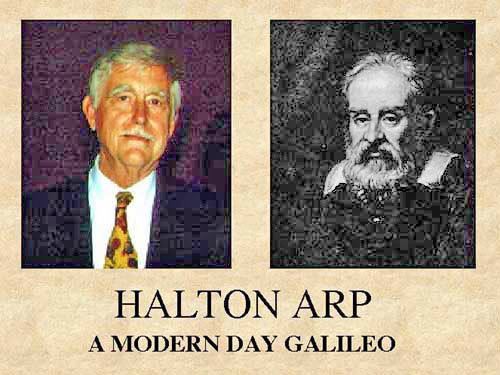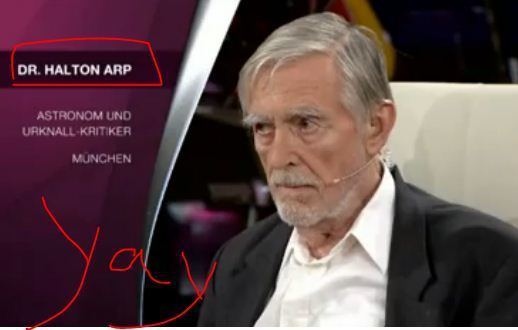Residence Germany Role Astronomer Nationality American Fields Astronomy | Children Andrice Arp Name Halton Arp | |
 | ||
Born March 21, 1927New York City, United States ( 1927-03-21 ) Institutions Palomar ObservatoryMax Planck Institute for Astrophysics Known for Intrinsic redshiftAtlas of Peculiar Galaxies Books Seeing Red: Redshifts, Catalogue of Discorda, A Catalogue of Southe, A Catalogue of Southe, Quasars - Redshifts and Contr Similar People Walter Baade, John N Bahcall, Jesse Reklaw | ||
Halton arp intrinsic red shift
Halton Christian "Chip" Arp (March 21, 1927 – December 28, 2013) was an American astronomer. He was known for his 1966 Atlas of Peculiar Galaxies, which (it was later realized) catalogues many examples of interacting and merging galaxies. Arp was also known as a critic of the Big Bang theory and for advocating a non-standard cosmology incorporating intrinsic redshift.
Contents
- Halton arp intrinsic red shift
- Halton arp and the electric universe space news
- Biography
- The Atlas of Peculiar Galaxies
- Characterizing quasars
- Arps suggestion
- Critics
- Honors and awards
- Books by Arp
- References

Halton arp and the electric universe space news
Biography

Arp was born on March 21, 1927, in New York City. He was married three times, has four daughters and five grandchildren. His bachelor's degree was awarded by Harvard (1949), and his PhD by Caltech (1953). Afterward he became a Fellow of the Carnegie Institution of Washington in 1953, performing research at the Mount Wilson Observatory and Palomar Observatory. Arp became a Research Assistant at Indiana University in 1955, and then in 1957 became a staff member at Palomar Observatory, where he worked for 29 years. In 1983 he joined the staff of the Max Planck Institute for Astrophysics in Germany. He died in Munich, Germany on December 28, 2013. He was an atheist.
The Atlas of Peculiar Galaxies

Arp compiled a catalog of unusual galaxies titled Atlas of Peculiar Galaxies, which was first published in 1966. Arp realized that astronomers understood little about how galaxies change over time, which led him to work on this project. This atlas was intended to provide images that would give astronomers data from which they could study the evolution of galaxies. Arp later used the atlas as evidence in his debate on quasi-stellar objects (QSOs).

Based on its citation by other astronomers, Arp's atlas is recognized now as an excellent compilation of interacting and merging galaxies. Many objects in the atlas are referred to primarily by their Arp number. Many of these objects (particularly Arp 220) are also used as spectral templates for studying high-redshift galaxies.
Characterizing quasars

During the 1950s bright radio sources, now known as quasars, had been discovered that did not appear to have an optical counterpart. In 1960 one of these sources, 3C 48, was found to be associated with what appeared to be a small blue star. When the spectrum of the star was measured, it contained unidentifiable spectral lines that defied all attempts at explanation; John Gatenby Bolton's suggestion that these were highly redshifted sources was not widely accepted.
In 1963 Maarten Schmidt found a visible companion to the quasar 3C 273. Using the Hale telescope, Schmidt found the same odd spectra, but was able to demonstrate that it could be explained as the spectrum of hydrogen, shifted by a very large 15.8% If this was due to the physical motion of the "star", it would represent a speed of 47,000 km/s, far beyond the speed of any known star and defying an obvious explanation. Nor would this explain the huge radio emissions that had led to its original detection.
Schmidt noted that redshift is also associated with the expansion of the universe, as codified in Hubble's law. If the measured redshift was due to expansion, then the object in question would have to be very far away. In that case, it would have to have an extraordinarily high luminosity, equally beyond any object seen to date. This extreme luminosity would also explain the large radio signal. Schmidt concluded quasars are very distant, very luminous objects.
Schmidt's explanation for the high redshift was not universally accepted at the time. Another explanation that was offered was that it was gravitational redshift that was being measured; this would require a massive object that would also explain the high luminosities. A star large enough to produce the measured redshift would be well beyond the Hayashi limit. Several other mechanisms were proposed as well, each with their own problems.
Arp's suggestion
In 1966, Arp published the Atlas of Peculiar Galaxies, which contained photographs of 338 nearby galaxies that did not fall into any of the classic categories of galaxy shapes. His goal was to produce a selection that modellers could use in order to test theories of galactic formation. By testing against the collection, one could quickly see how well a particular theory stood up.
One group of these, numbers 1 through 101, were otherwise conventional galaxies that appeared to have small companion objects of unknown origin. In 1967 Arp noted that several of these objects appeared on the list of quasars. In some photographs a quasar is in the foreground of known galaxies, and in others there appeared to be matter bridging the two objects, implying they are very close in space. If they are, and the redshifts were due to Hubble expansion, then both objects should have similar redshifts. The galaxies had much smaller redshifts than the quasars. Arp argued that the redshift was not due to Hubble expansion or physical movement of the objects, but must have a non-cosmological or "intrinsic" origin.
Arp also noted that quasars were not evenly spread over the sky, but tended to be more commonly found in positions of small angular separation from certain galaxies. This being the case, they might be in some way related to the galaxies. Arp's hypothesis is that quasars are local objects ejected from the core of active galactic nuclei (AGN). Nearby galaxies with both strong radio emission and peculiar morphologies, particularly M87 and Centaurus A, appeared to support Arp's hypothesis.
In his books, Arp has provided his reasons for believing that the Big Bang theory is wrong, citing his research into quasars or quasi-stellar objects (QSOs). Instead, Arp supported the redshift quantization theory as an explanation of the redshifts of galaxies.
Critics
Arp originally proposed his theories in the 1960s; telescopes and astronomical instrumentation have advanced greatly since then: the Hubble Space Telescope was launched, multiple 8-10 meter telescopes (such as those at Keck Observatory and the Very Large Telescope) have become operational, and detectors such as CCDs are now more widely employed. These new telescopes and new instrumentation have been used to examine QSOs further. QSOs are now generally accepted to be very distant galaxies with high redshifts. Many imaging surveys, most notably the Hubble Deep Field, have found many high-redshift objects that are not QSOs but that appear to be normal galaxies like those found nearby. The spectra of the high-redshift galaxies, as seen from X-ray to radio wavelengths, match the spectra of nearby galaxies (particularly galaxies with high levels of star formation activity but also galaxies with normal or extinguished star formation activity) when corrected for redshift effects. As more recent experiments have expanded the amount of collected data by orders of magnitude Arp's theories can now be scrutinized further. For instance a recent study about the periodicity of redshifts (a hypothesis articulated by Arp) stated that:
"... the publicly available data from the Sloan Digital Sky Survey and 2dF QSO redshift survey to test the hypothesis that QSOs are ejected from active galaxies with periodic noncosmological redshifts. For two different intrinsic redshift models, [...] and find there is no evidence for a periodicity at the predicted frequency in log(1+z), or at any other frequency."However, a follow-up study by Bell and McDiarmid shows that Arp's hypothesis about the periodicity in red-shifts cannot be discarded easily. The authors argue (as response to Tang and Zhang (2005) from which the preceding excerpt is taken) that
"The Tang and Zhang (2005) analysis could thus have missed, or misidentified, many of the parent galaxies, which could explain why the pairs they found differed little from what would be expected for a random distribution. In spite of this, although it was not pointed out by these authors, their pairs did show a slight excess near the expected value of 200 kpc….In fact, most of the conclusions reached by Tang and Zhang (2005) appear to have resulted because they have assumed that many of the values [that they have used] are much more accurate than they really are. …[we found by examining 46400 quasars from Sloan Digital Sky Survey that] the locations of the peaks in the redshift distribution are in agreement with the preferred redshifts predicted by the intrinsic redshift equation"Arp did not waver from his stand against the Big Bang, and until shortly before his death continued to publish articles stating his contrary view in both popular and scientific literature, frequently collaborating with Geoffrey Burbidge (until his death in 2010) and Margaret Burbidge.
Honors and awards
In 1960, Arp was awarded the Helen B. Warner Prize for Astronomy by the American Astronomical Society, a prize "normally awarded annually for a significant contribution to observational or theoretical astronomy during the five years preceding the award."
In the same year, Arp was awarded the Newcomb Cleveland Prize for his address, "The Stellar Content of Galaxies", read before a joint session of the American Astronomical Society and AAAS Section D.
In 1984, he was awarded the Alexander von Humboldt Senior Scientist Award.
